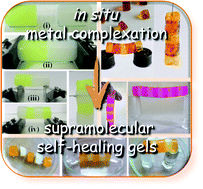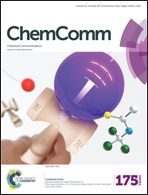Supramolecular metallogels with bulk self-healing properties prepared by in situ metal complexation
Abstract
In this feature article, we discuss a series of contributions dealing with the in situ fabrication of supramolecular metallogels (i.e. using low molecular weight ligands and metal ions) that show self-healing properties of the bulk gel phase after complete physical segregation. Most of the advances in this area have taken place during the last three years and are mainly represented by organogels, whereas examples of hydrogels and organic-aqueous gels are still a minority. In situ gelation via metal-coordination of low molecular weight compounds is conceptually different from the use of premade (e.g. in solution) coordination polymers and polymeric structures as gelators and ligands, respectively. In the case of in situ gelation, the cooperative effects of all components of the mixture (i.e. ligand, metal ion, counterions and solvent molecules) in an appropriate ratio under well-defined experimental conditions play a crucial role in the gelation phenomenon and self-healing properties of the material.


 Please wait while we load your content...
Please wait while we load your content...